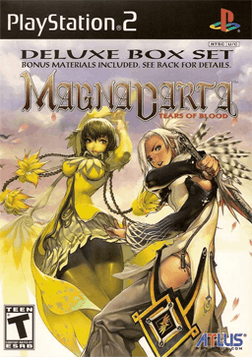Magna Carta: Crimson Stigmata
| Magna Carta: Crimson Stigmata Magna Carta: Tears of Blood | |
|---|---|
|
North American PlayStation 2 cover art | |
| Developer(s) | Softmax |
| Publisher(s) | |
| Director(s) | Yeon-Kyu Choi |
| Producer(s) |
Shintarō Miura Young-Gee Cho Lee Jackie |
| Designer(s) | Seok-Hwan Jeon |
| Programmer(s) | Chang-Geun Lim |
| Artist(s) |
Hyung-tae Kim Ki-Nam Kim |
| Writer(s) |
Rae-Yeon Lee Byung-Soo Kwon Junko Okazaki |
| Composer(s) | Sung-Woon Jang |
| Series | Magna Carta |
| Engine | Unreal Engine 2 |
| Platform(s) | PlayStation 2, PlayStation Portable |
| Release date(s) | |
| Genre(s) | Role-playing |
| Mode(s) | Single-player |
Magna Carta: Crimson Stigmata is a role-playing video game developed by Softmax and originally released for the PlayStation 2 in South Korea by Softmax and in Japan by Banpresto in 2004. It is the second installment of the Magna Carta and a sequel to the 2001 game Magna Carta: The Phantom of Avalanche. The game was later released as Magna Carta: Tears of Blood in the United States and as simply Magna Carta in Europe, also for the PlayStation Portable.
Gameplay
The game's battle elements borrow from Shadow Hearts and the Star Ocean series. Up to three characters may move around the battlefield in real time. The player can only control one character at a time and can only attack after the character fills its "leadership meter" by remaining still. Once filled, the character can initiate an attack by performing a series of three timed button presses (known as the "trinity ring"). If the attack is unsuccessful, the leadership meter empties, and the player must wait for it to refill again.
The three modes of combat that are uniquely embedded are "standard", "combo" and "counter". The standard mode is excellent for offensive and defensive attacks. By perfecting the timing of the buttons, characters will learn stronger attacks. Combo attacks lack defense but are generally used to create powerful offensive attacks by combining all attacks in one turn. The counter mode does what its name implies; not only is the user able to block, but also attack by predicting their enemies' attacks. Players using this mode do not exhaust their leadership meter. Characters may attack with various combat "styles" learned in the game, which use different chi (energy) types to increase their utility. There are eight different types of chi present in all areas, but in different exhaustible quantities.
Plot
The game takes place in the land of Efferia, where a seemingly endless war has raged between the continent's two species: Humans and Yason. Humans and Yason are similar in appearance, but Yason have lighter skin and differently shaped ears. The protagonist of the game, Calintz, is a high-ranking leader of the Tears of Blood, a mercenary squad hired out by the Human Alliance to deal with problems they cannot, or will not, touch. Since the group is not part of the official army, the mercs are disliked by the Alliance soldiers. The core group also consists of Azel, a youthful sword wielder who looks up to Calintz, Eonis, a powerful mage, and Haren, a martial artist. Save for Azel, all group members have a heavy grudge against the Yason for the deaths of friends and family. The Blast Worms, highly skilled Yason soldiers, are led by the Four Warriors, an elite group who wields great power and magic.
When the Alliance's use of the "forbidden magic" fails, Calintz stops an assault by one of the Four Warriors' summoned familiars. After destroying a bridge to prevent enemy advancement, he finds himself in a cavern being healed by an unfamiliar woman. Because she suffers from amnesia, all she remembers is her name, Reith, and that she can use very powerful healing magic. Eventually, they find their way out of the cave and, as a show of thanks for saving him, Calintz offers to take her to Amabat, a city of high-ranking and powerful priestesses, thinking her to be one of them. As the story progresses, Reith, as well as the Tears of Blood and Blast Worms, learn that she is a much more important piece of the puzzle than anyone had realized.
Reception
Reviews of Magna Carta: Tears of Blood were mixed. The game averaged 67% on review aggregator GameRankings[2] and 66/100 score on Metacritic.[3] GameSpot gave the game 7.1 out of 10 claiming the "well-developed cast of characters keeps the story interesting" but its "extremely linear campaign feels restrictive at times".[4] IGN's review stated that "the poorly-executed battle system ... runs into too many problems for its own good". They scored the game 6.1 out of 10.[5] Yahoo! and IGN heavily criticized the game's English voice acting and called it "really uninspired"[6] and "Ill-timed, badly-acted, and poorly cast".[5]
References
- ↑ "Japanese Release Dates Update". IGN. Retrieved 23 October 2014.
- ↑ "Magna Carta: Tears of Blood for PlayStation 2". GameRankings. 2005-11-16. Retrieved 2012-02-22.
- ↑ "Magna Carta: Tears of Blood for PlayStation 2". Metacritic. 2005-11-16. Retrieved 2014-10-01.
- ↑ Greg Mueller (2005-11-29). "Magna Carta: Tears of Blood Review". GameSpot. Retrieved June 30, 2012.
- 1 2 "Magna Carta: Tears of Blood". IGN.
- ↑ Justin Leeper (November 11, 2005). "Magna Carta: Tears of Blood Review". Yahoo!. Archived from the original on December 27, 2007.
External links
- Official website (North America)
- Magna Carta: Crimson Stigmata at MobyGames
